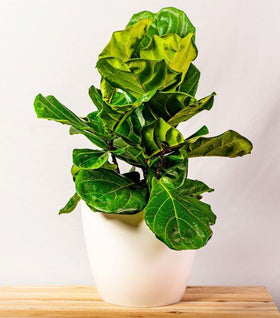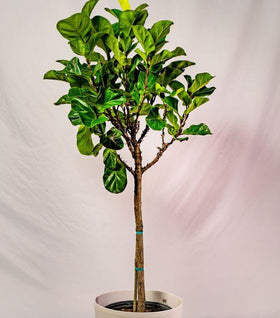Fiddle Leaf Fig Plants for Sale Online
Arguably one of the most popular house plants available, Fiddle Leaf Figs are loved by gardeners of all experience levels. Known for their large, distinct, violin-shaped leaves, this plant comes in both a tall tree and a bush. While it’s technically not a true fig plant in that it will not produce fruit, it is still a member of the fig or ficus family. It’s a long standing favorite among interior designers for its versatility and ability to complement any decor.
This tough plant adapts easily to conditions and once acclimated it can grow to 6 feet tall or taller. Whether you live in a spacious home or cozy apartment, a live Fiddle Leaf Fig plant is the perfect addition and will escalate the charm to a whole new level. Shop our selection of Fiddle Leaf Figs for sale below!
Benefits of Buying Live Fiddle Leaf Fig Plants
Out of all of the house plants that are available out there, why should you buy a Fiddle Leaf Fig? They have rapidly grown in popularity and recognition for several reasons:
1. It’s Highly Versatile
Trends come and go, but the Fiddle Leaf Fig is here to stay. A major reason why it’s such a popular houseplant is that it matches any style - modern, contemporary, coastal, country-chic, and more! It’s a surefire way to update a room and add style without the hassle and resources required for renovating.
2. It Cleans the Air
Not only is this plant aesthetically appealing, but it’s functional. The broad, violin-shaped leaves make it a highly efficient air purifying plant. So you can breathe easier in your home or office knowing that your live Fiddle Leaf Fig plant will remove common toxins from the air, such as formaldehyde, dioxins, and more.
3. Minimal Care
Fiddle Leaf Fig plants can be intimidating since they do require certain conditions to grow, but they are not too difficult to care for. Once they have had a chance to settle and adjust to a new environment, they grow well with minimal maintenance. Just make sure to watch the leaves for any warning signs, such as underwatering (continue reading for the care instructions).
Is Buying a Fiddle Leaf Fig Plant Right for You?
While Fiddle Leaf Figs are immensely popular and many people love the idea of having one, it’s important to know if buying one is the right fit for your home. Once it has established itself in its new home, these plants are not as intimidating as you may have been told. However, there are some things to consider before ordering one:
Conditions
Fiddle leaf figs are known to be one of the more difficult houseplants to care for; however, this is only because the Fiddle Leaf Fig Ficus is rather particular about its living conditions. Ideal conditions for the Fiddle Leaf Fig include bright indirect light and a well-draining soil medium.
Pet Safety
While these plants may be beautiful, Fiddle Leaf Figs are mildly toxic to pets and humans if the leaves are ingested.
Depending on the behavior of your pet and if they are known for interacting with plants, a Fiddle Leaf Fig Tree may not be the best choice for your home. However, smaller variations of this plant can be placed on elevated shelves or furniture where it would be out of reach and harm's way from your pet.
Reduce Movement
Avoid fussing or moving your Ficus Lyrata too often; Fiddle Leaf Figs do not like to be moved—if necessary to move your plant, be prepared for your tree to drop leaves until it is acclimated again in approximately 2-3 weeks.
Leaves turning yellow and dropping is also common following the shipping process. It is important to note that leaf drop is completely normal, as travel is stressful! Once acclimated to its new home, the leaves will stop falling and new green leaves will appear.
Space
If you buy this tropical plant in a smaller pot, keep in mind that it will eventually reach tree size. If this intimidates you, rest assured that they are slow-growing.
Nonetheless, it’s important to map out the space in your home for where you want it to fit. If you opt for a tree, it is a substantial specimen that will take up space. Fiddle Leaf Fig trees reach a mature average height of 6 to 8 feet indoors.
Tree variations add instant impact achieving a more eye-catching look. If you're concerned with your ability to grow this plant, start with a smaller plant and get a feel for it. You can always purchase a larger specimen once you hone your skills. Smaller plants also make great desk plants and you'll be the envy of the office.
How to Care for Live Fiddle Leaf Fig Plants
Light
Fiddle Leaf Fig plants will grow best with consistent, bright, filtered light, such as an east-facing window. Turn the plant every few months to keep the growth even. Fiddle leaf figs prefer an east-facing, sunny window. Bright afternoon sun from the south or west-facing windows will be too strong and tend to burn the leaves.
Water
Water your Fiddle Leaf Fig when the top inch or so of the soil becomes dry. Pushing your finger into the soil is a great way to get a sense of the water in the soil. We recommend placing a dish or saucer with gravel under the plant to collect the excess water.
When needed, thoroughly drench until the water drains into the saucer. Empty the saucer if the plant is sitting in water so as not to drown the roots. Brown spots on the leaves and mushy stems may indicate root rot. This is where a pot with good drainage is essential for the well-being of your indoor tree!
A major sign that your plant may not be getting enough water is if the leaves become floppy, and eventually turn brown and fall off. If this happens, alter your water schedule to raise the moisture level in the soil.
Humidity
Ficus lyrata prefers higher humidity levels and the easiest way to accomplish this is to mist the leaves with a spray bottle occasionally. Misting should be done more often in the winter when humidity levels are lower due to household heating systems.
Temperature
The Fiddle Leaf Fig prefers warmer temperatures but will adapt easily to your home or office climate. They do not like cold drafts, so make sure you seal up drafty areas before situating your fig near windows or doorways. The easiest gauge of temperature is that if you are comfortable in your living room or office, so is your plant.
Potting Soil
Any quality well-drained potting soil will do. When choosing a potting mix select high-quality soil with larger particle sizes. Peat-based soils are best to maintain a healthy plant. Espoma Organic Potting Mix is a great option, but we have also seen phenomenal results with Ocean Forest Potting Mix.
Cleaning the Leaves
The large leaves tend to collect dust. If you notice the leaves are dusty, wipe them with a damp cloth using clean water and gently dry them to keep them clean and healthy.
Bonide Leaf Shine is a good product that will add extra shine and reduce the ability of dust to stick to the leaves. It also helps to reduce the plant's ability to lose moisture through the leaves. This will help with keeping the moisture level higher within the plant.
Fertilizer
Feed your plant once during the spring and monthly throughout the summer. For beginners, it's very easy to use Osmocote Plus as this product will slowly release nutrients into the soil as you water.
Be careful not to over-fertilize the tree as this can cause the plant to grow leggy and in some cases even result in the death of the tree. No fertilizer is necessary during the winter when plant growth naturally slows.



